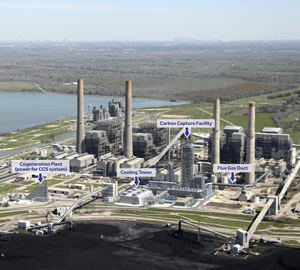W.A. PARISH COAL PLANT NOW RUNNING ‘CLEAN’ IN RICHMOND, HELPING BOOST OIL EMISSIONS FURTHER SOUTH  The years-long retrofitting of the W.A. Parish coal plant next to Smithers Lake in Richmond was capped off last week by a valve opening ceremony, at which the plant’s new Petra Nova carbon dioxide collection machinery was ceremonially turned on (though NRG says its been running since September). The new machinery is currently the largest such capture operation in the country, and might help knock the plant down a few notches from its recent high score on the carbon pollution rankings. Monica Simmons of the San Antonio Current, however, points out this week that whether the project actually results in a net reduction of CO2 emissions is something of a question mark: The project, which has been in the works since the over-$70-a-barrel days of 2010, is helping to pay for itself by piping that excess CO2 down to Jackson County and into the ground at the West Ranch oil field — which NRG says will help the folks there squeeze out 15,000 barrels of oil a day instead of 300. [San Antonio Current; previously on Swamplot] Photo of W.A. Parish Generating Station and labeled Petra Nova add-ons: NRG
The years-long retrofitting of the W.A. Parish coal plant next to Smithers Lake in Richmond was capped off last week by a valve opening ceremony, at which the plant’s new Petra Nova carbon dioxide collection machinery was ceremonially turned on (though NRG says its been running since September). The new machinery is currently the largest such capture operation in the country, and might help knock the plant down a few notches from its recent high score on the carbon pollution rankings. Monica Simmons of the San Antonio Current, however, points out this week that whether the project actually results in a net reduction of CO2 emissions is something of a question mark: The project, which has been in the works since the over-$70-a-barrel days of 2010, is helping to pay for itself by piping that excess CO2 down to Jackson County and into the ground at the West Ranch oil field — which NRG says will help the folks there squeeze out 15,000 barrels of oil a day instead of 300. [San Antonio Current; previously on Swamplot] Photo of W.A. Parish Generating Station and labeled Petra Nova add-ons: NRG
Tag: Power Plants
DUBAI’S ENERGY PLAN WOULD PUT SOLAR PANELS ON EVERY ROOFTOP BUT WOULDN’T CUT CONSUMPTION Meanwhile, in Dubai: The United Arab Emirates, long a global symbol of extravagant wealth derived from the oil industry, is hoping to step into an equally dramatic role in the green energy scene — the recently-announced Dubai Clean Energy Strategy 2050 calls for 25 percent of Dubai’s energy to come from clean sources by 2030, ramping up to 75 percent by 2050. The plan calls for solar panels to be placed on all rooftops in the city, and for a 5,000 megawatt solar energy park, which will generate nearly 10 times as much electricity as the next-largest such park currently in existence, California’s Solar Star. The push comes alongside neighboring Saudi Arabia’s movement toward solar energy, rooted in efforts to reserve more oil for export and remain a dominant fossil fuel force. [CityLab, the Atlantic]

